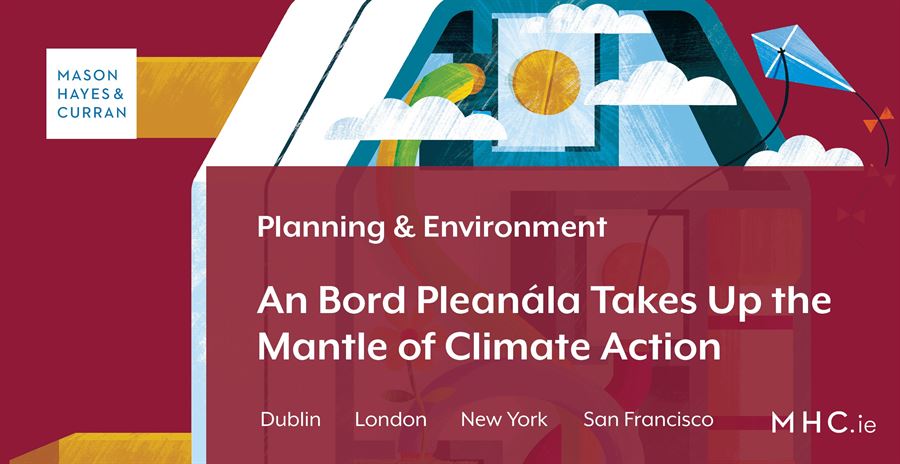
In a number of recent decisions, An Bord Pleanála has signalled that it is increasingly prepared to examine projects capable of having a direct or indirect effect on greenhouse gas emissions through the lens of what is required to achieve Ireland’s overall climate action targets, and to refuse planning permission for development utilising technologies seen as harmful for the climate. While the full implications of this trend have yet to be established, developers of projects which have the potential for direct and indirect contribution to greenhouse gas emissions should take note.
An Bord Pleanála’s planning policy toolkit
The Climate Action Plan (CAP) published by the Government in June 2019 includes a specific objective to “Reduce our carbon footprint by integrating climate action into the planning system in support of national targets for climate policy mitigation and adaptation objectives, as well as targets for greenhouse gas emissions reductions.”
The National Planning Framework, which was adopted in May 2018, also focuses on the formulation of suitable planning policy to respond to the requirement to reduce greenhouse gas emissions. The CAP and the National Planning Framework have expanded the policy toolkit of An Bord Pleanála (ABP) to enable ABP to take measures to support climate change mitigation. This policy toolkit has been reinforced in legal terms as the National Planning Framework has a statutory basis as the primary planning policy document within the planning hierarchy mandated by an amendment to the Planning and Development Act 2000. These policy and legal tools available to ABP for climate mitigation have also been reinforced by an increasing focus at a societal and political level on climate change, with Dáil Éireann declaring a ‘climate emergency’ in May 2019. These developments have led to what appears to be a decisive shift in what ABP understands as representing ‘proper planning and sustainable development’ when it is considering projects with the potential for climate change impacts.
 Co-firing versus exclusive firing of biomass
Co-firing versus exclusive firing of biomass
An example of this shift which has gained media attention has been ABP’s approach to the co-firing of biomass in the peat fired power stations in the midlands. In December 2016 ABP gave an extension of duration of planning permission to Bord na Mona to continue co-firing of biomass with peat at its power plant at Edenderry, County Offaly until 2023. Emphasis was placed on the proposition that co-firing with biomass facilitated the transition from fossil fuel in the form of peat to the exclusive use of a renewable source of energy such as biomass. ABP concluded, having considered the Government’s climate change polices in effect at that time, that the proposal for the co-firing of biomass with peat was in accordance with ‘proper planning and sustainable development’.
Fast forward less than three years, and the Board came to a very different conclusion concerning a very similar proposal to extend the duration of planning permission for the co-firing of peat with biomass at the ESB owned West Offaly Power station located at Shannonbridge, County Offaly. The ESB also characterised the project as facilitating the transition towards the exclusive firing of the facility by renewable sources, allowing for the continued operation of the power plant which provides valuable employment in the midlands area. In considering the proposal ABP referenced the requirements of the Climate Action Plan and the National Planning Framework in coming to its determination. ABP concluded that having regard to national, EU and international climate change mitigation obligations that the proposed development ran contrary to ‘proper planning and sustainable development’ due to the fact that the biomass would be largely imported and transported to the midlands by HGV from ports. Without an indigenous supply of biomass it was impossible to conclude that the development would actually lead to a decrease in greenhouse gas emissions. Furthermore, ABP concluded the continued firing of peat for electricity production was no longer acceptable in planning policy terms due to the higher emissions profile of this energy source.
Further steps towards sustainability
Other examples of this change in what ABP considers to be developments representing proper planning and sustainable development have become apparent recently. One of which included a proposal by the Minister for Culture, Heritage and An Gaeltacht to provide an alternative site for the cutting of domestic fuel peat on an inactive cutaway bog at Coolrea, County Kildare. This proposal accommodated traditional turf-cutters who had been prohibited by the NPWS from cutting turf on a Natura 2000 protected bog in order to comply with the EU Habitats Directive. ABP determined that the continued use of peat was contrary to the Climate Action policy objective to transition to a low-carbon energy system. Ultimately, ABP refused permission for the development, while acknowledging that the development was aimed at ensuring compliance with other legal obligations of the State.
Comment
It can be seen that ABP through recent decisions is taking decisive steps to position itself as a key instrument to achieve the progressive decarbonisation of the economy which the Government has committed to in the Climate Action Plan.
While these recent decisions have in many instances came as a surprise to the developers, overall the fact that ABP has taken up the mantle of climate leadership on the back of the Climate Action Plan and the National Planning Framework is to be welcomed. However, the ever-changing concept of ‘proper planning and sustainable development’ particularly for the climate impacts of developments, suggest that developers should pay particular attention at project conception stage to the life-cycle climate impacts of their projects. Developers should also ensure that developments going into the planning process are in line with the requirements of the Climate Action Plan then in force, as well as any relevant advice provided by the Climate Change Advisory Council.
For more information on sustainable development, contact a member of our Planning & Environment team.
The content of this article is provided for information purposes only and does not constitute legal or other advice.



